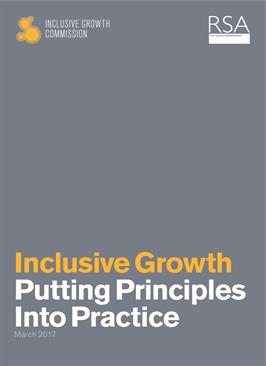How do we make inclusive growth a reality? Our 'Putting principles into practice' guide explores the ways in which numerous places are starting to find ways to spread prosperity more widely.
The hard work has to be done in our cities and towns to identify what inclusive growth can and must mean for particular places, and how places can achieve this individually and collectively. This guide provides a version of the Commission’s proposals which might be used by those who need answers most urgently, the mayors, chief executives and councillors around the nation. It is not an instruction manual. Nor do we necessarily have all the answers. What we do have is a collection of experience of what is actually happening on the ground, which shows us that inclusive growth is possible.
Inclusive growth: putting principles into practice builds on the Commission’s final report and on our five principles of inclusive growth:
- Creating a shared, binding mission– The complexity of the challenge of inclusive growth demands a shared, binding commitment to the task with a common narrative about the vision for change, how it can be achieved and the roles that business, civil society, central and local government can play in this. This needs to be a national agenda, designed and delivered locally, where there is a stronger sense of identity and where people have a greater stake in the outcome. As a citizen of a place with a binding mission for inclusive growth, I know that there are opportunities for me to make a contribution to the local economy and my community, and for this to be valued. I feel that I belong to a place that matters, and is heading somewhere.
- Measuring the human experience of growth, not just its rate – Let’s measure what we value and want to achieve from inclusive growth. Is it easy and affordable for everyone to travel to work and to access public services? Do working age people have access to quality jobs, where they are paid fairly and have opportunities to learn and progress? Is there a difference in the healthy life expectancy between certain groups in my community? Do people believe in their own future and their ability to succeed? We need to make inclusive growth our yardstick of economic success, capturing the value of our social as well as economic infrastructure.
- See growth as a social system, not just a machine – Get underneath the skin of the problem inclusive growth is designed to solve, including what is having an impact, where and why, and where services or spending are having perverse effects on inclusive growth outcomes. At a place level, this will involve data analysis, public engagement, democratic processes and deliberations with employers, investors, public service professionals and civic institutions. How might this process signal opportunities for change? Are there sticking points that might just have be worked around? At a national level, how might the system need to be rewired – structurally and culturally – to support inclusive growth ‘on the ground’?
- Be an agile investor at scale – Ensuring sufficient, strategic, integrated finance of social and physical infrastructure so as to maximise the value of public, private and third sector investment across generations. This might require a shift of spending towards preventative, rather than reactive spend, as well as scope for more flexible use of smaller-scale funding to pump-prime public innovation and social enterprise.
- Entrepreneurial, whole-place leadership – Bringing together, at a place level, business, civil society and political leaders, formally and informally, to drive system-change. This will involve mobilising the full force of local resources and stakeholders to build on existing assets and opportunities, as well as develop new innovative and investable propositions for change. This will demand: clarity of vision for what actions are needed, the means to respond dynamically as circumstances shift, the capacity for economic leadership, ability to think creatively about what (or who) might present an opportunity for impact to create change, the courage to experiment, iterate and scale, and the humility to learn from failure. Places that have strong entrepreneurial leadership understand the need for a broad-based movement for change, building local legitimacy and channelling the collective energy of wider civil society.
Download Inclusive Growth: Putting principles into practice (PDF, 6.2MB)
Read the report online (on Medium)
pdf 1.3 MB
